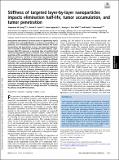Stiffness of targeted layer-by-layer nanoparticles impacts elimination half-life, tumor accumulation, and tumor penetration
Author(s)
Kong, Stephanie M; Costa, Daniel F; Jagielska, Anna; Van Vliet, Krystyn J; Hammond, Paula T
DownloadPublished version (1.419Mb)
Publisher Policy
Publisher Policy
Article is made available in accordance with the publisher's policy and may be subject to US copyright law. Please refer to the publisher's site for terms of use.
Terms of use
Metadata
Show full item recordAbstract
<jats:title>Significance</jats:title>
<jats:p>Layer-by-layer nanoparticles (LbL NPs), comprised of a charged core substrate layered sequentially with oppositely charged polyelectrolytes, are a promising class of drug delivery carriers for cancer therapeutics with demonstrated success in lowering off-target toxicity and enhancing efficacy. However, little is known about how LbL NP stiffness alters trafficking and delivery. Herein, we report that the stiffness of targeted LbL NPs, comprised of a liposome core and tumor-targeting, polymeric outer layers, can be tuned by altering the mechanical properties of its underlying liposomal core. We also show that these changes have a significant impact on in vivo NP trafficking properties; compliant LbL NPs have longer elimination times, higher organ and tumor accumulation, and higher tumor penetration.</jats:p>
Date issued
2021Department
Koch Institute for Integrative Cancer Research at MIT; Massachusetts Institute of Technology. Department of Chemical Engineering; Massachusetts Institute of Technology. Department of Materials Science and Engineering; Massachusetts Institute of Technology. Department of Biological EngineeringJournal
Proceedings of the National Academy of Sciences of the United States of America
Publisher
Proceedings of the National Academy of Sciences
Citation
Kong, Stephanie M, Costa, Daniel F, Jagielska, Anna, Van Vliet, Krystyn J and Hammond, Paula T. 2021. "Stiffness of targeted layer-by-layer nanoparticles impacts elimination half-life, tumor accumulation, and tumor penetration." Proceedings of the National Academy of Sciences of the United States of America, 118 (42).
Version: Final published version